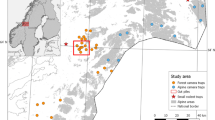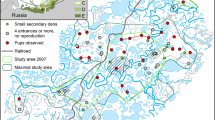Abstract
In Scandinavia, an increased red fox Vulpes vulpes density during the last decades has been suggested to be caused by direct and indirect human influences on food availability. Recently, attention has been focused on the role of increasing scavenging opportunities due to intensified hunting of ungulates and the reestablishment of large carnivores. In our study, we investigated seasonal and annual variations in diet composition of red fox in Varaldskogen, SE Norway, an area with cyclic voles and a high density of moose Alces alces. Analyses of scats revealed significant differences among seasons in the occurrence of ungulates—mainly moose—and ungulates were the dominating food category during winter (44.9 % of all remains). Snow tracking of red fox (71 km) in winter confirmed the importance of ungulate carcasses, i.e. one case of scavenging per 3 km. The proportions of voles were high during all seasons (11.2–28.8 %); in spite of variation in available abundances, no significant seasonal or annual differences were detected. Other food categories with seasonal variation were birds, berries/seeds and amphibians/reptiles, all more common in snow-free seasons. Our study underlines the importance of ungulate remains during periods when the abundance and diversity of alternative food sources is low. Increased and stabilized populations of red foxes—mediated through remains from hunting and wolf kills from high moose populations—might have an important effect on the population dynamics of small game. Hence, we recommend that this relationship be given attention in future studies.


Similar content being viewed by others
References
Angelstam P, Lindstrøm E, Widen P (1984) Role of predation in short-term population fluctuations of some birds and mammals in Fennoscandia. Oecologia 62:199–208
Angerbjörn A, Tannerfeldt M, Erlinge S (1999) Predator–prey relationships: arctic foxes and lemmings. J Anim Ecol 68:34–49
Brom TG (1986) Microscopic identification of feathers and feather fragments of Palearctic birds. Bijdragen tot deDierkunde 56(2):181–204
Burnham KP, Anderson RD (2002) Model selection and multimodel inference: a practical information-theoretic approach. Springer Verlag, New York
Cagnacci F, Lovari S, Meriggi A (2003) Carrion dependence and food habits of the red fox in an alpine area. Italian J Zool 70:31–38
Chamrad AD, Box TW (1964) A point-frame method for sampling rumen contents. J Wildl Manag 28:473–477
Ciucci P, Tosoni E, Boitani L (2004) Assessment of the point-frame method to quantify wolf Canis lupus diet by scat analysis. Wildl Biol 10:149–153
Dell’Arte GL, Laaksonen T, Norrdahl K, Korpimäki E (2007) Variation in the diet composition of a generalist predator, the red fox, in relation to season and density of main prey. Acta Oecol 31:271–281
DeVault TL, Rhodes OR Jr, Shivik JA (2003) Scavenging by vertebrates: behavioural, ecological and evolutionary perspectives on an important energy transfer pathway in terrestrial ecosystems. Oikos 102:225–234
Day MG (1966) Identification of hair and feather remains in the gut and faeces of stoats and weasels. J Zool 148:201–217
Hagen Y (1969) Norwegian studies on the reproduction of birds of prey andowls in relation to micro-rodent fluctuations. Fauna 22:73–126
Helle P, Belkin V, Bljudnik L, Danilov PI, Jakimov A (2003) Changes in grouse populations in Finland and Russian Karelia during past decades. Suomen Riista 49:32–43
Henttonen H (1989) Does an increase in the rodent and predator densities, resulting from modern forestry, contribute to the longterm decline in Finnish tetraonids? Suomen Riista 35:83–90, In Finnish with English summary
Jędrzejewski W, Jędrzejewska B (1992) Foraging and the diet of the red fox Vulpes vulpes in relation to variable food resources in Białowieza National Park, Poland. Ecography 15:212–220
Kidawa D, Kowalczyk R (2011) The effect of sex, age, season and habitat on diet of the red fox Vulpes vulpes in northeastern Poland. Acta Theriol 56:209–218
Killengreen ST, Lecomte N, Ehrich D, Schott T, Yoccoz NG, Ims RA (2011) The importance of marine vs. human-induced subsidies in the maintenance of an expanding mesocarnivore in the arctic tundra. J Anim Ecol 80:1049–1060
Kjellander P, Nordström J (2003) Cyclic voles, prey switching in red fox, and roe deer dynamics—a test of the alternative prey hypothesis. Oikos 101:338–344
Klare U, Kamler JF, MacDonald DW (2011) A comparison and critique of different methods for determining carnivore diet. Mammal Rev 41(4):294–312
Korpimäki E, Klemola T, Norrdahl K, Oksanen L, Oksanen T, Banks PB, Batzli GO, Henttonen H (2003) Vole cycles and predation. Trends Ecol Evol 18(10):494–495
Lack D (1954) The natural regulation of animal numbers. Oxford University Press, Oxford
Lindström ER (1982) Population ecology of the red fox (Vulpes vulpes L.) in relation to food supply. Ph.D. Thesis, University of Stockholm, Sweden
Lindström ER, Andrén H, Angels P, Cederlund G, Hörnfeldt B, Jäderberg L, Lemnell PA, Martinson B, Sköld K, Swenson JE (1994) Disease reveals the predator: sarcoptic mange, red fox predation, and prey populations. Ecology 75:1042–1049
Marcström V (1979) A review of the tetraonid situation in Sweden. Proc Int Grouse Symp 1:13–16
Marcström V, Kenward RE, Engren E (1988) The impact of predation on boreal tetraonids during vole cycles: an experimental study. J Anim Ecol 57:859–872
Myrberget S (1974) Variations in the production of willow grouse Lagopus lagopus (L.) in Norway 1963–1972. Ornis Scand 5:163–172
Nowak RM (2005) Walker’s carnivores of the world. The John Hopkins University Press, Baltimore, Maryland
O’Mahony D, Lambin X, MacKinnon JL, Coles CF (1999) Fox predation on cyclic field vole populations in Britain. Ecography 22:575–581
Ostfeld RS, Keesing F (2000) Pulsed resources and community dynamics of consumers in terrestrial ecosystems. Trends Ecol Evol 15(6):232–237
Reynolds JC, Aebischer NJ (1991) Comparison and quantification of carnivore diet by faecal analysis: a critique, with recommendations, based on a study of the red Fox Vulpes vulpes. Mammal Rev 21(3):97–122
Selås V, Vik JO (2006) Possible impact of snow depth and ungulate carcasses on red fox (Vulpes vulpes) populations in Norway, 1897–1976. J Zool 269:299–308
Selva N (2004) The role of scavenging in the predator community of Białowieża Primeval Forest (E. Poland). Ph.D. Thesis, Polish Academy of Science, Poland, and the University of Sevilla, Sevilla, Spain
Selva N, Jędrzejewska B, Jędrzejewski W, Wajrak A (2003) Scavenging on European bison carcasses in Bialowieza Primeval Forest (eastern Poland). Ecoscience 10(3):303–311
Selva N, Jędrzejewska B, Jędrzejewski W, Wajrak A (2005) Factors affecting carcass use by a guild of scavengers in European temperate woodland. Can J Zool 83:1590–1601
Sillero-Zubiri C, Hoffmann M, Macdonald DW (2004) Canids: foxes, wolves, jackals and dogs: Status Survey and Conservation Action Plan. IUCN/SSC Canid Specialist Group
Skonhoft A (2006) The costs and benefits of animal predation: an analysis of Scandinavian wolf re-colonisation. Ecol Econ 58(4):830–841
Smedshaug CA, Selås V, Lund SE, Sonerud GA (1999) The effect of a natural reduction of red fox Vulpes vulpes on small game hunting bags in Norway. Wildl Biol 5:157–166
Statistics Norway (2011)http://www.ssb.no
Statistics Norway (2013) http://www.ssb.no
Statistics Statskog (2013) http://www.statskog.no
Teerink BJ (1991) Hair of West European mammals: Atlas and identification key. Cambridge University Press, Cambridge
Wabakken P, Aronson Å, Strømseth TH, Sand H, Maartman E, Svensson L, Flagstad O, Hedmark E, Liberg O, Kojola I (2010) The wolf in Scandinavia: status report of the 2009–2010 winter. Oppdragsrapport4-2010. Høgskolen i Hedmark, Elverum. (In Norwegian with English summary, figures and tables.)
Wegge P (1979) Status of capercaillie and black grouse in Norway. Int Grouse Symp 1:17–26
Wegge P, Rolstad J, Gjerde I (1992) Effects of habitat fragmentation on capercaillie grouse: empirical evidence and management implications. In: McCullough DR, Barrett RH (eds) Wildlife 2001: Populations. Elsevier Science Publishers, Amsterdam, pp 738–749
Wegge P, Rolstad J (2011) Clearcutting forestry and Eurasian boreal forest grouse: long-term monitoring of sympatric capercaillie Tetrao urogallus and black grouse Tetrao tetrix reveals unexpected effects on their population performances. Forest Ecol and Manag 261:1520–1529
Wegge P, Shrestha R, Flagstad Ø (2012) Snow leopard Panthera uncia predation on livestock and wild prey in a mountain valley in northern Nepal: implications for conservation management. Wildl Biol 18:131–141
Wikenros C (2011) The return of the wolf—effects on prey, competitors and scavengers. Ph.D. Thesis, Swedish University of Agricultural Sciences, Uppsala
Wikenros C, Sand H, Ahlqvist P, Liberg O (2013) Biomass flow and scavengers use of carcasses after Re-colonization of an apex predator. PLoS One 8(10):e77373. doi:10.1371/journal.pone.0077373
Wilmers CC, Stahler DR, Crabtree RL, Smith DW, Getz WM (2003a) Resource dispersion and consumer dominance: scavenging at wolf and hunter killed carcasses in Greater Yellowstone, USA. Ecol Lett 6:996–1003
Wilmers CC, Crabtree RL, Smith DW, Murphy KM, Getz WM (2003b) Trophic facilitation by introduced top predators: grey wolf subsidies to scavengers in Yellowstone National Park. J Anim Ecol 72:909–916
Yalden DW, Morris PA (1990) The analysis of owl pellets. Mammal Society Occasional Publications 13. Mammal Society, London
Acknowledgments
We would like to thank the Norwegian Directorate for Nature Management and the Department of Ecology and Natural Resource Management, the Norwegian University of Life Sciences, for financial support
Author information
Authors and Affiliations
Corresponding author
Additional information
Communicated by: Rafał Kowalczyk
Rights and permissions
About this article
Cite this article
Needham, R., Odden, M., Lundstadsveen, S.K. et al. Seasonal diets of red foxes in a boreal forest with a dense population of moose: the importance of winter scavenging. Acta Theriol 59, 391–398 (2014). https://doi.org/10.1007/s13364-014-0188-7
Received:
Accepted:
Published:
Issue Date:
DOI: https://doi.org/10.1007/s13364-014-0188-7




